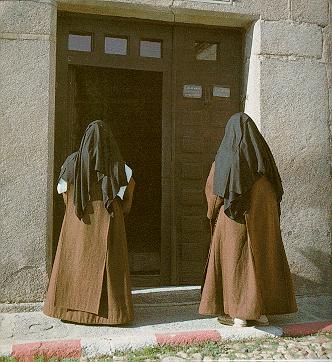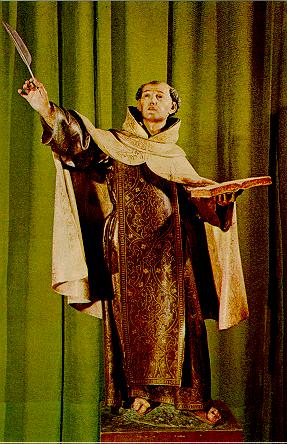 Chapter Fifteen: The Nuns
Chapter Fifteen: The Nuns
 We came out of the vestibule and into the courtyard as a brown Mercedes drove in. Gerd exclaimed
"Ah, how wonderful! This is wonderful! You will meet the nuns!" She practically leaped with joy. "This
never happens!" The young man driving, the husband of the young woman we had met earlier, had
gotten out and was letting two nuns out of the car. Gerd stood watching, then looked to us with a bursting
smile.
We came out of the vestibule and into the courtyard as a brown Mercedes drove in. Gerd exclaimed
"Ah, how wonderful! This is wonderful! You will meet the nuns!" She practically leaped with joy. "This
never happens!" The young man driving, the husband of the young woman we had met earlier, had
gotten out and was letting two nuns out of the car. Gerd stood watching, then looked to us with a bursting
smile.
 When the nuns, one tall and one short, had gotten out and adjusted their habits, she greeted them and
they her, with smiles all round. They had been to the doctor, and she hoped there were no problems.
"No, it's nothing," smiled one. Her friendly tone imparted no information either way and closed the subject.
I remembered my readings of St. Teresa and her feelings about how the formative and humbling nature
of "trials" and illness can bring one closer to God, and supposed that it might not really matter to them
either way in the larger scheme of their chosen life. Just let it all happen.
When the nuns, one tall and one short, had gotten out and adjusted their habits, she greeted them and
they her, with smiles all round. They had been to the doctor, and she hoped there were no problems.
"No, it's nothing," smiled one. Her friendly tone imparted no information either way and closed the subject.
I remembered my readings of St. Teresa and her feelings about how the formative and humbling nature
of "trials" and illness can bring one closer to God, and supposed that it might not really matter to them
either way in the larger scheme of their chosen life. Just let it all happen.
 Gerd introduced us, saying our ages, that we were Americans and that I was in Spain to visit all of St.
Teresa's foundations. The two nuns, one tall, one short, greeted us. Gerd briefly explained their
household functions. The shorter nun was the kitchen mistress. The taller nun, who towered over me,
came close and put her hand behind my neck. With a gently sustained pressure, she held my neck
with a hand that felt softer, cooler and more soothing than a cloud, so that my face was very close to
hers. She beamed at me.
Gerd introduced us, saying our ages, that we were Americans and that I was in Spain to visit all of St.
Teresa's foundations. The two nuns, one tall, one short, greeted us. Gerd briefly explained their
household functions. The shorter nun was the kitchen mistress. The taller nun, who towered over me,
came close and put her hand behind my neck. With a gently sustained pressure, she held my neck
with a hand that felt softer, cooler and more soothing than a cloud, so that my face was very close to
hers. She beamed at me.
 We continued this way for what felt to me like, well, an eternity - though it could not have been more than
a couple of minutes at most, the tall nun softly and firmly grasping my neck, looking towards Gerd to ask
questions about me, and turning her affectionate glance to me again. I was able to understand and
speak a little for myself, but at the same time was completely involved in the sensation of the nun's soft
hand and her nearness to the exclusion of almost everything else. Finally she released me. I felt I was in
the presence of angels.
We continued this way for what felt to me like, well, an eternity - though it could not have been more than
a couple of minutes at most, the tall nun softly and firmly grasping my neck, looking towards Gerd to ask
questions about me, and turning her affectionate glance to me again. I was able to understand and
speak a little for myself, but at the same time was completely involved in the sensation of the nun's soft
hand and her nearness to the exclusion of almost everything else. Finally she released me. I felt I was in
the presence of angels.
 And, that light again! Both nuns' faces glowed. Their smiles had none of the faint, involuntary tightness
reflecting the social uncertainty of a first meeting with strangers. They seemed completely relaxed and
at ease in a way difficult to describe. Only once before have I met people who have lived in a lifetime in
enclosed religious community, at the
And, that light again! Both nuns' faces glowed. Their smiles had none of the faint, involuntary tightness
reflecting the social uncertainty of a first meeting with strangers. They seemed completely relaxed and
at ease in a way difficult to describe. Only once before have I met people who have lived in a lifetime in
enclosed religious community, at the  Trappist monastery of the Holy Spirit in Conyers, Georgia. While I
was walking in the part of the grounds open to the public during the day, a white haired, white robed monk
came my way and greeted me.
Trappist monastery of the Holy Spirit in Conyers, Georgia. While I
was walking in the part of the grounds open to the public during the day, a white haired, white robed monk
came my way and greeted me.
 He asked me how I enjoyed the chapel with its famous stained glass windows, he asked me about
my family, whether I was married. He took my hand in his and caressed it, then he took my other hand
as he continued to ask me questions. This had made me very uncomfortable, and more than a little
anxious to be on my way, and embarrassed for feeling that way in the first place. He kept me talking
for several minutes, never letting go of my hands. His hands were soft and warm and his face was
open and glowing with affection. After a while we said goodbye, he released my hands, and we walked
off in different directions, the old monk smiling.
He asked me how I enjoyed the chapel with its famous stained glass windows, he asked me about
my family, whether I was married. He took my hand in his and caressed it, then he took my other hand
as he continued to ask me questions. This had made me very uncomfortable, and more than a little
anxious to be on my way, and embarrassed for feeling that way in the first place. He kept me talking
for several minutes, never letting go of my hands. His hands were soft and warm and his face was
open and glowing with affection. After a while we said goodbye, he released my hands, and we walked
off in different directions, the old monk smiling.
Thomas Merton, who lived for many years as a Trappist monk at Gethsemani,
the mother house of the monastery of the Holy Spirit
 When I thought about it later, it seemed to me that the elderly monk's affection, so freely shown, to me
and to others, was of a kind I had never witnessed or experienced before. Most especially in the case
of the older ones, living cloistered lives for, I suppose, almost all of their lives. These strange men had
no reason ever to build shells around themselves in the way that we are normally accustomed to doing,
and never had. I realized it might mean that I had never before met anyone so truly open. How could
this be?
When I thought about it later, it seemed to me that the elderly monk's affection, so freely shown, to me
and to others, was of a kind I had never witnessed or experienced before. Most especially in the case
of the older ones, living cloistered lives for, I suppose, almost all of their lives. These strange men had
no reason ever to build shells around themselves in the way that we are normally accustomed to doing,
and never had. I realized it might mean that I had never before met anyone so truly open. How could
this be?

 Gerd began to explain the symbolism and purpose of the nuns' habits. The habit is a sort of sacred
object in itself, which is treated with reverence and affection. It is made of hand spun and woven frieze,
the same as Santa Teresa wore, and represents their tie with her and their special way of life. They
wear the same habit all year, through the heat and cold, both of which, in Avila, can be extreme. As
Gerd described each part, the nuns showed us. The shorter nun pulled back the sleeve of the taller
nun's habit to reveal the white wool undergarment she wore.
Gerd began to explain the symbolism and purpose of the nuns' habits. The habit is a sort of sacred
object in itself, which is treated with reverence and affection. It is made of hand spun and woven frieze,
the same as Santa Teresa wore, and represents their tie with her and their special way of life. They
wear the same habit all year, through the heat and cold, both of which, in Avila, can be extreme. As
Gerd described each part, the nuns showed us. The shorter nun pulled back the sleeve of the taller
nun's habit to reveal the white wool undergarment she wore.
 They showed us how they pull up the hems of their habits to avoid soiling them when they work. The
taller nun noticed a piece of lint on the shorter one's breast and reached over tenderly to pluck it off.
She didn't ask permission, nor did her sister take particular notice. Gerd told us the scapular
represents a symbolic embrace by Mary. Both nuns raised the parts of their scapulars draped
beneath the belt and kissed them. The taller one did this a second time, I think to make sure we
saw and understood. They lifted their hems once more to show us their
alpargates, the high-soled
rope sandals they wear in Teresian tradition, year round. Teresa's reformed Carmelites are known
as the Disclaced, the "shoeless ones."
They showed us how they pull up the hems of their habits to avoid soiling them when they work. The
taller nun noticed a piece of lint on the shorter one's breast and reached over tenderly to pluck it off.
She didn't ask permission, nor did her sister take particular notice. Gerd told us the scapular
represents a symbolic embrace by Mary. Both nuns raised the parts of their scapulars draped
beneath the belt and kissed them. The taller one did this a second time, I think to make sure we
saw and understood. They lifted their hems once more to show us their
alpargates, the high-soled
rope sandals they wear in Teresian tradition, year round. Teresa's reformed Carmelites are known
as the Disclaced, the "shoeless ones."
 Gerd told them I had received the address of their sister in Bufalo.
They smiled and embraced us,
kissing us on both cheeks, and telling us to give their sister in Bufalo un abrazo from them.
They moved
toward the cloister door. The young man was waiting for them. He would enter with them to carry out
some repair work. The nuns must have people in and out to do odd jobs and repairs. Gerd told us,
however, that in order for the nuns to come out of the cloister to go to the doctor, which is just about the
only time they do, they go through a ceremony that permits them to walk unveiled, showing the face
of a Carmelite to the world as a sort of witness. When they return, another ritual is enacted to welcome
them back into the embrace of enclosure.
Gerd told them I had received the address of their sister in Bufalo.
They smiled and embraced us,
kissing us on both cheeks, and telling us to give their sister in Bufalo un abrazo from them.
They moved
toward the cloister door. The young man was waiting for them. He would enter with them to carry out
some repair work. The nuns must have people in and out to do odd jobs and repairs. Gerd told us,
however, that in order for the nuns to come out of the cloister to go to the doctor, which is just about the
only time they do, they go through a ceremony that permits them to walk unveiled, showing the face
of a Carmelite to the world as a sort of witness. When they return, another ritual is enacted to welcome
them back into the embrace of enclosure.
 The nuns smiled at us once more, then turned to the door to enter the cloister. We left the courtyard to
walk around the street front of the compound, to the door of the church. Gerd produced an outsized old
fashioned key on a ring similar to those belonging to San Josť. We entered the church whose
exuberant baroque gold leaf encrusted decorations gleamed in the faint light. We came near to
admire the polychromed statues of St. Teresa and St. John of the Cross in their altar niches. I believe
I felt a different kind of nearness to a saint who has been very alive for me, but whom I'd now seen
through very different eyes.
The nuns smiled at us once more, then turned to the door to enter the cloister. We left the courtyard to
walk around the street front of the compound, to the door of the church. Gerd produced an outsized old
fashioned key on a ring similar to those belonging to San Josť. We entered the church whose
exuberant baroque gold leaf encrusted decorations gleamed in the faint light. We came near to
admire the polychromed statues of St. Teresa and St. John of the Cross in their altar niches. I believe
I felt a different kind of nearness to a saint who has been very alive for me, but whom I'd now seen
through very different eyes.

Chapter 16: An Odor of Incense,
List of Chapters, or Back Home
 Trappist monastery of the Holy Spirit in Conyers, Georgia. While I
was walking in the part of the grounds open to the public during the day, a white haired, white robed monk
came my way and greeted me.
Trappist monastery of the Holy Spirit in Conyers, Georgia. While I
was walking in the part of the grounds open to the public during the day, a white haired, white robed monk
came my way and greeted me. 

 Chapter Fifteen: The Nuns
Chapter Fifteen: The Nuns